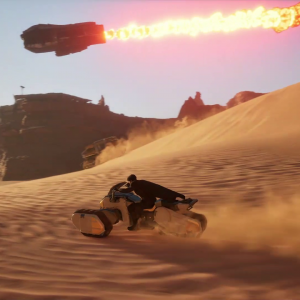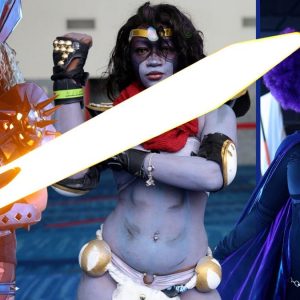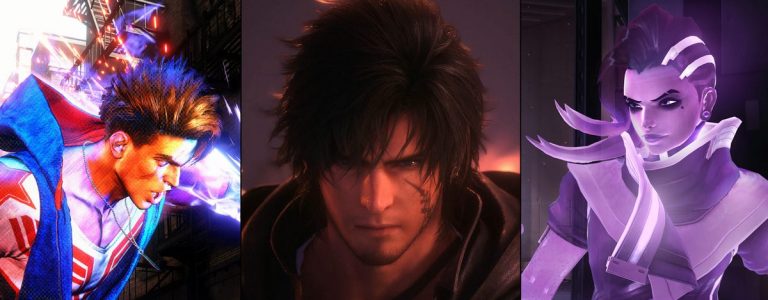The legendary Shawn Michaels retired from pro wrestling in 1998 after suffering a career-ending back injury at the Royal Rumble. No one expected him to lace up his boots and step back into the ring again, yet the Heartbreak Kid made a triumphant return in 2002, eventually going on to cement his legacy with unforgettable matches against the likes of Triple H, The Undertaker, and Ric Flair. The quality of the second half of Michaels’ career ensured that his surprise comeback would be remembered as one of the most spectacular returns in WWE history, and it’s one that’s echoed in some ways by WWE 2K23. Following the disaster that was 2K20–a game so bad its successor was outright canceled–developer Visual Concepts returned to the squared circle last year with a solid foundation that 2K23 improves upon in a variety of ways, finally putting the long-running series back on form with a surprise comeback Mr. WrestleMania himself would be proud of.
Little has changed since last year’s entry from a gameplay perspective. You still alternate between light and heavy strikes to execute various combos; grapple your opponent to hit them with suplexes, DDTs, and spinning neck breakers; and build up meters to gain access to signature moves and flashy match-ending finishers. Some may bemoan that it still doesn’t play like No Mercy–an N64 game that many still consider the best wrestling game ever–but the series has never tried to. 2K23 is a solid wrestling sim, with most matches swaying back and forth as momentum shifts via desperate reversals and last-ditch kick-outs.
The improvements Visual Concepts has implemented are subtle, yet prove to be welcome adjustments, successfully banishing some minor annoyances from 2K22. The timing window on reversals, for instance, has been tightened up. Previously, it was a little too easy to turn the tide of a contest thanks to the generous amount of time you were given to nullify an attack. With a shorter window, reversals feel more impactful this year, encouraging you to study your opponent’s move set and sharpen your reaction times as a result. This ensures matches are more engaging and also imbues each one with some added tension.
The new pin-break mechanic, where you flick the right stick up to mimic a kick-out, also enhances the in-ring action. It’s not a huge, game-changing addition, but nailing the timing of this simple mini-game becomes more challenging later on in matches when your energy is waning, and there’s something about imitating the physicality of a wrestler erupting out of a pin that adds to the drama. You can still stick with button-mashing if you’d prefer, but flicking the right stick just makes more sense on a fundamental level.
The other changes to 2K23’s action aren’t as immediately obvious, but it doesn’t take too long to notice how each one has a positive impact. There’s a stronger emphasis on stamina in this year’s game, with wrestlers slowing down the longer a match lasts. You can perform in-ring springboard attacks as well, and tag teams will work together in the Royal Rumble instead of immediately trying to eliminate each other. The AI has also been tweaked so that each Superstar behaves closer to their real-life counterparts–which means you won’t see a giant like Omos flying off the top turnbuckle. You can even access sliders to edit these tendencies yourself–Fire Pro Wrestling style–so those who enjoy running AI vs. AI match-ups should be able to create matches that aren’t too far removed from what we see on an episode of Smackdown each week.
The AI, in general, is much improved from last year, as Superstars tend to use their full repertoire this time around, even utilizing possum attacks and leverage pins to get the jump on you. Tag-team AI isn’t as busy as it was in 2K22 either. Teammates don’t break up submission and pin-fall attempts as frequently as they used to, and you can strike your opponent’s teammate when they’re standing on the apron to inflict a stun state, so tag matches flow more smoothly. The AI does still have a tendency to throw you outside the ring a little too often, and there are some janky collision issues that will make you miss attacks you really shouldn’t, but these are minor inconveniences in the grand scheme of things.
The headline new match type in 2K23 is WarGames, which pits teams of either three or four Superstars against each other inside a cage containing two rings. Teammates enter the cage at alternating intervals, giving one squad a numerical advantage until everyone is in. The match doesn’t technically start until every competitor has entered the cage, so much of the drama comes from these shifting power dynamics. There’s a risk and reward element also at play, forcing you to consider whether you want to hit your big moves early on or save them until later when pin attempts actually count. WarGames is inherently chaotic in real life, and it’s arguably even more so in 2K23, which is part of its unruly charm. It’s surprising how well it all works. Even though you’re locked inside a cage, the space you’re working with is actually fairly large, so you have room to execute your offense, and pin attempts aren’t broken up as constantly as they are when a bunch of Superstars are crammed into a single ring. At any one point, you could have a one-on-one match occurring in one ring, two competitors utilizing the space between the rings to inflict some unique offense, while everyone else is involved in an all-out brawl involving tables and chairs, with one Superstar standing on top of the cage, ready to launch themselves onto an unsuspecting foe below.

Gallery
Showcase mode returns once again, this time putting the spotlight on John Cena’s 20-year WWE career. The 16-time world champion gives candid interviews to talk you through some of his greatest matches and rivalries, with you then recreating them by completing various objectives throughout each match as archive footage seamlessly melds with the in-game action. In a neat twist, you don’t actually play as Cena, instead taking on the role of some of the Superstars who have defeated him over the years. When someone wins as often as Cena did–to the point where he was practically unbeatable at times–it makes his losses all the more notable, so it’s a smart direction for 2K23’s Showcase mode. Plus, playing as a different character in each match helps to freshen up the formula.
Unfortunately, it’s just not as engaging as it could’ve been. After Cena’s pre-match monologue, there’s no follow-up during or after the match to lend each conflict some gravitas or a sense of time and place. Instead of commentary, you’re left listening to underwhelming crowd noises and a generic soundtrack that quickly begins to grate. While the transitions between gameplay and real footage are still impressive, there are also a few occasions where you have to sit and watch a match play out for a few minutes at a time. These moments can feel like an eternity, especially when it feels like you could pull off the sequence yourself.
On the flipside, 2K23’s MyRise is much improved over last year’s offering. This is 2K’s take on a career mode, although it would be more accurate to call it a story mode considering losses don’t count unless they’re part of the narrative. There are two distinct storylines to play through, one for the men and one for the women. If you create a male character, you’ll suit up as The Lock, a world-traveled indie wrestler who joins the WWE as “the next big thing.” You win the Intercontinental Title in your very first match, but you’re also saddled with an awful gimmick by management, so there’s some immediate tension. If you create a female Superstar, you’re cast as the niece of a fictitious WWE Hall of Famer. Your first match is a bit of a disaster, so you’re taken off TV and have to work your way back up, attempting to forge your own path as a second-generation Superstar while emerging from the shadow of your famous aunt.
Both storylines are immersive and a ton of fun, undulating between serious feuds and goofier moments. Occasionally, you also have choices to make that will alter the trajectory of your story and determine which Superstars are willing to align with you in the future. These range from deciding whether or not to use a chair to gain the upper hand or picking which rebooted faction to join: Evolution or The Hurt Business. Much of MyRise is very on the nose and self-referential, and the writing displays a love of wrestling that even extends beyond the all-encompassing bubble that is WWE. Unlike 2K22’s offering, this year’s game also isn’t saddled with an over-reliance on in-game social media to tell its stories. The faux Twitter feed still exists, but it’s used sparingly and is essentially a tool for getting you into some side quests and optional challenges. The bulk of the narrative is much more focused, with an overarching storyline and voice acting from the majority of the active roster. If there’s one downside, it’s that the loading times in MyRise are egregiously long. When you’re jumping between matches and fine-tuning your appearance, entrance, move-sets, and so on, be expected to sit through the kinds of lengthy load screens that don’t normally exist on PS5.
Universe mode, MyGM, and MyFaction all return this year, too. The former still gives you full creative control to book your own episodes of Raw, Smackdown, and NXT, playing as either a single Superstar or an omnipotent booker who picks and chooses which matches to partake in. Visual Concepts has also added a substantial new feature to 2K23 that lets you choose from dozens of different rivalry actions to take place during each match, from a pre-match sucker punch, post-match kendo stick attack, or tag-team breakdown to a show of sportsmanship or a mid-match distraction from a conniving manager. You can guarantee a specific action will occur or leave it up to a coin toss to add an element of randomness to rivalries. It still doesn’t compete with the collusion-fueled antics of the exhaustive story designer last seen in WWE 2K14, but it’s a step in the right direction.

Gallery
MyGM adds the mid-card US and Intercontinental titles this time around so your roster isn’t just competing for a single championship. Other than this, it’s still the overwhelming mode it was last year, as you draft a roster for your chosen brand, taking into consideration the budget, synergy between different types of wrestlers, and their heel and face alignments. Then you go about constructing a three-match show each week, all with the end goal of earning buckets of money, winning the ratings war, and eventually entering the Hall of Fame by completing various objectives.
There are more General Managers to choose from in 2K23, including both Xavier Woods and Tyler Breeze–so you can recreate their Battle of the Brands rivalry from UpUpDownDown. Each GM has specific Power Cards you can trigger to change the tide of a show by sabotaging a rival or bolstering yourself, perhaps by stealing one of their Superstars or ensuring that a TLC match receives a higher-than-normal rating on your show. There’s a fairly robust tutorial, but it still takes a while to wrap your head around how everything works and how best to put on a successful event each week. Fortunately, MyGM is no longer a one-and-done mode. You can opt to carry on playing for multiple seasons–with fresh objectives popping up to keep things interesting–so there’s more time to get to grips with how it all works. If you didn’t enjoy MyGM last year, the newest iteration isn’t likely to sway you, but Visual Concepts clearly took some of the feedback on board to create a more comprehensive and rewarding mode.
If you’d rather focus on simply competing in the squared circle, 2K23’s card-based MyFaction is on hand to give you just that, with the caveat that it also wants whatever’s in your wallet. Much like the previous iteration, MyFaction revolves around collecting cards, building teams of four, and then taking them into challenge towers, live events, and other challenges against the AI. The difference this year is that you can also fight human opponents for the first time, but this has the side effect of ensuring there will be a race to obtain the best cards. 2K23 doesn’t have an online marketplace where you can buy specific cards using an in-game currency like similar modes in the likes of FIFA and Madden; the fastest way to collect new cards is by purchasing packs with real money. You can earn packs, single cards, and in-game money by playing the game, but attaining these rewards is a massive time sink. Considering the most expensive version of 2K23 costs an eye-watering $120, asking you to part with more money to potentially acquire a special card is egregious, even if it’s mostly par for the course with these types of modes. It’s equally disappointing that gimmick and attire updates are still exclusive to MyFaction when they should really take effect in every mode to better reflect the on-screen product.
These misgivings aside, WWE 2K23 sees the series build on its immediate predecessor and return to form after hitting rock bottom (pun intended) with the infamous 2K20. Almost every mode has been improved–with the exception of Showcase and MyFaction–while the in-ring action is as polished as ever. WarGames is a fun and chaotic new addition, and the likes of Universe, MyGM, and MyRise are endlessly playable to the point where they could keep you busy by the time next year’s WrestleMania rolls around.
























